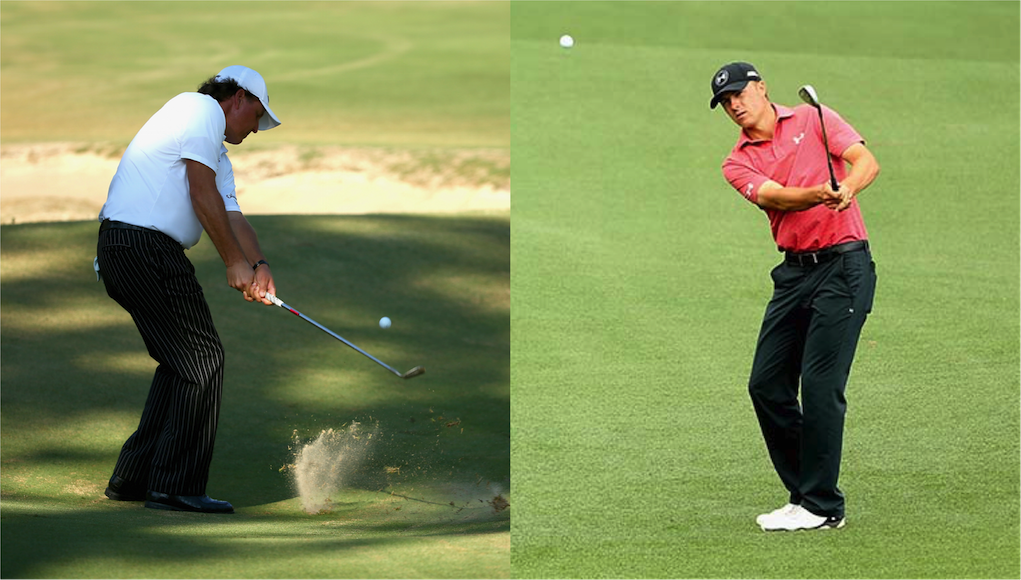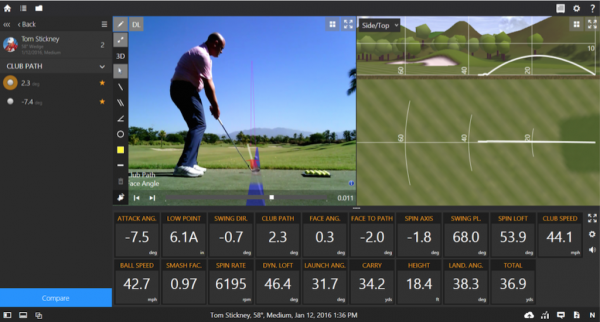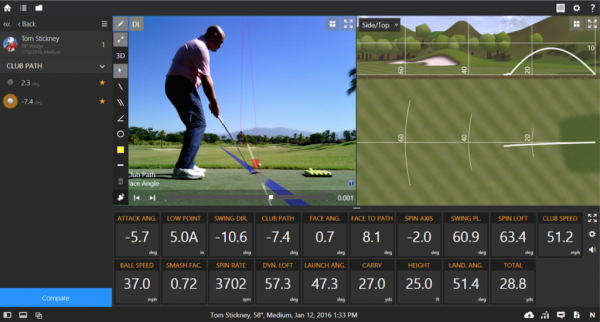Instruction
The difference between a pitch shot and a flop shot on Trackman

One of the best feelings in golf is executing a delicate flop shot over a bunker; take a mighty rip and watch the ball rise quickly, fall slowly toward the ground, land near the pin and stop dead. It’s an unbelievable sense of accomplishment, but few people actually know how to hit this type of shot, or how they happen.
In this article, I’m going to show you information you’ve probably never seen before so you can understand how to actually hit the “flop” and channel your inner Phil. Let’s look at what a pitch shot with my 58-degree wedge looks like on Trackman, and compare it to a flop shot with the same club.
Pitch Shot
- The path mirrors my normal swing with an in-to-out club path of 2.3 degrees.
- The face angle is slightly left of the path (but right of the target) at 0.3 degrees.
- This ball carried 34.2 yards with a spin rate of 6195 rpm.
- The peak height of this shot was 18.4 feet with a landing angle of 38.3 degrees.
Flop Shot
- The club path changes to excessively out-to-in at -7.4 degrees.
- The face angle is right of the path AND right of the target at 0.7 degrees, giving us an excessive face-to-path ratio of 8.1 degrees.
- Clubhead speed was much higher in the flop versus the normal shot at 51.2 mph versus 44.1 mph, as was the dynamic loft at impact at 57.3 degrees versus 46.4 degrees.
- The ball carried only 27 yards versus 34.2 yards on the normal shot, but only had 3702 rpm of spin.
- The height of this shot was 25 feet with a landing angle of 51.4 degrees. The steeper landing angle helps the ball stop more quickly on the green, despite the reduced spin.
Now that you understand how these two shots differ, let me give you my six simple keys that will help you execute flop shots more effectively.
- Use your highest-lofted wedge to execute the shot.
- Aim your body left of the target so you can shift your swing direction and swing path more out-to-in.
- The face should be open at address relative to your body alignment; it should point at your target, or just a little right of it depending on how high you want to hit the shot.
- Allow the swing to follow the alignments of your body so that the club moves up and away in the backswing, and then cuts across the target line through impact.
- STAY in your posture through impact and keep rotating through the ball so the handle does not raise through impact. Doing so can cause shanks and “wiped” shots, because the more the handle lifts the more the hosel is pushed toward the ball and the more the blade opens.
- Allow the rotation of the right shoulder to ensure that you keep “moving” through impact. You don’t want to stop accelerating, because you’ll end up chunking or blading the shot. Be confident and aggressive!
- LIKE54
- LEGIT12
- WOW3
- LOL0
- IDHT2
- FLOP11
- OB8
- SHANK54
Instruction
Clement: Laid-off or perfect fade? Across-the-line or perfect draw?

Some call the image on the left laid off, but if you are hitting a fade, this could be a perfect backswing for it! Same for across the line for a draw! Stop racking your brain with perceived mistakes and simply match backswing to shot shape!
- LIKE0
- LEGIT0
- WOW0
- LOL0
- IDHT0
- FLOP0
- OB0
- SHANK1
Instruction
The Wedge Guy: The easiest-to-learn golf basic

My golf learning began with this simple fact – if you don’t have a fundamentally sound hold on the golf club, it is practically impossible for your body to execute a fundamentally sound golf swing. I’m still a big believer that the golf swing is much easier to execute if you begin with the proper hold on the club.
As you might imagine, I come into contact with hundreds of golfers of all skill levels. And it is very rare to see a good player with a bad hold on the golf club. There are some exceptions, for sure, but they are very few and very far between, and they typically have beat so many balls with their poor grip that they’ve found a way to work around it.
The reality of biophysics is that the body moves only in certain ways – and the particulars of the way you hold the golf club can totally prevent a sound swing motion that allows the club to release properly through the impact zone. The wonderful thing is that anyone can learn how to put a fundamentally sound hold on the golf club, and you can practice it anywhere your hands are not otherwise engaged, like watching TV or just sitting and relaxing.
Whether you prefer an overlap, interlock or full-finger (not baseball!) grip on the club, the same fundamentals apply. Here are the major grip faults I see most often, in the order of the frequency:
Mis-aligned hands
By this I mean that the palms of the two hands are not parallel to each other. Too many golfers have a weak left hand and strong right, or vice versa. The easiest way to learn how to hold the club with your palms aligned properly is to grip a plain wooden ruler or yardstick. It forces the hands to align properly and shows you how that feels. If you grip and re-grip a yardstick several times, then grip a club, you’ll see that the learning curve is almost immediate.
The position of the grip in the upper/left hand
I also observe many golfers who have the butt of the grip too far into the heel pad of the upper hand (the left hand for right-handed players). It’s amazing how much easier it is to release the club through the ball if even 1/4-1/2″ of the butt is beyond the left heel pad. Try this yourself to see what I mean. Swing the club freely with just your left hand and notice the difference in its release from when you hold it at the end of the grip, versus gripping down even a half inch.
To help you really understand how this works, go to the range and hit shots with your five-iron gripped down a full inch to make the club the same length as your seven-iron. You will probably see an amazing shot shape difference, and likely not see as much distance loss as you would expect.
Too much lower (right) hand on the club
It seems like almost all golfers of 8-10 handicap or higher have the club too far into the palm of the lower hand, because that feels “good” if you are trying to control the path of the clubhead to the ball. But the golf swing is not an effort to hit at the ball – it is a swing of the club. The proper hold on the club has the grip underneath the pad at the base of the fingers. This will likely feel “weak” to you — like you cannot control the club like that. EXACTLY. You should not be trying to control the club with your lower/master hand.
Gripping too tightly
Nearly all golfers hold the club too tightly, which tenses up the forearms and prevents a proper release of the club through impact. In order for the club to move back and through properly, you must feel that the club is controlled by the last three fingers of the upper hand, and the middle two fingers of the lower hand. If you engage your thumbs and forefingers in “holding” the club, the result will almost always be a grip that is too tight. Try this for yourself. Hold the club in your upper hand only, and squeeze firmly with just the last three fingers, with the forefinger and thumb off the club entirely. You have good control, but your forearms are not tense. Then begin to squeeze down with your thumb and forefinger and observe the tensing of the entire forearm. This is the way we are made, so the key to preventing tenseness in the arms is to hold the club very lightly with the “pinchers” — the thumbs and forefingers.
So, those are what I believe are the four fundamentals of a good grip. Anyone can learn them in their home or office very quickly. There is no easier way to improve your ball striking consistency and add distance than giving more attention to the way you hold the golf club.
More from the Wedge Guy
- The Wedge Guy: Golf mastery begins with your wedge game
- The Wedge Guy: Why golf is 20 times harder than brain surgery
- The Wedge Guy: Musings on the golf ball rollback
- LIKE88
- LEGIT13
- WOW6
- LOL1
- IDHT0
- FLOP4
- OB1
- SHANK8
Instruction
Clement: Stop ripping off your swing with this drill!

Not the dreaded headcover under the armpit drill! As if your body is defective and can’t function by itself! Have you seen how incredible the human machine is with all the incredible feats of agility all kinds of athletes are accomplishing? You think your body is so defective (the good Lord is laughing his head off at you) that it needs a headcover tucked under the armpit so you can swing like T-Rex?
- LIKE0
- LEGIT2
- WOW2
- LOL0
- IDHT0
- FLOP0
- OB0
- SHANK2
-

 19th Hole3 weeks ago
19th Hole3 weeks agoDave Portnoy places monstrous outright bet for the 2024 Masters
-

 19th Hole7 days ago
19th Hole7 days agoJustin Thomas on the equipment choice of Scottie Scheffler that he thinks is ‘weird’
-

 19th Hole3 weeks ago
19th Hole3 weeks agoTiger Woods arrives at 2024 Masters equipped with a putter that may surprise you
-

 19th Hole6 days ago
19th Hole6 days ago‘Absolutely crazy’ – Major champ lays into Patrick Cantlay over his decision on final hole of RBC Heritage
-

 19th Hole2 weeks ago
19th Hole2 weeks agoTwo star names reportedly blanked Jon Rahm all week at the Masters
-

 19th Hole2 weeks ago
19th Hole2 weeks agoReport: LIV Golf identifies latest star name they hope to sign to breakaway tour
-

 19th Hole2 weeks ago
19th Hole2 weeks agoNeal Shipley presser ends in awkward fashion after reporter claims Tiger handed him note on 8th fairway
-

 19th Hole2 weeks ago
19th Hole2 weeks agoBrandel Chamblee has ‘no doubt’ who started the McIlroy/LIV rumor and why


















McDuff
Mar 8, 2016 at 10:20 pm
Thanks, this is very accurate and relevant information that most people don’t know…..you should see people trying to flop with no idea how to do it, it’s quite funny….don’t know why people ‘shank’ the article but offer no insights at all….
Tim
Feb 16, 2016 at 7:20 pm
@Rich IMO the pitch is great up until about 40% of the full swing distance of my lob wedge (or if I’m inside that, but have a lot of green to work with). Inside of that, the roll out is often too great because I have to swing too slow to generate the required spin. That’s where I switch to the flop to use the height to get the ball to sit. So, I’m not sure the numbers showing the two shot types carrying the same distance tells me anything useful to bring onto the course.
steve
Feb 13, 2016 at 8:00 am
I love how he edits the comments. Nice removal of comments
Zak Kozuchowski
Feb 13, 2016 at 4:03 pm
Steve,
It’s our moderating team that removes comments, not authors. Please read our rules and terms to better understand why we removed your comment: http://www.golfwrx.com/forums/?app=forums&module=extras§ion=boardrules
Steve
Feb 13, 2016 at 8:15 pm
The most open, honest, friendly, and most respected golf site on the web.
How can you have a open and honest website when you delete opinions that are opposite of your agenda
Zak Kozuchowski
Feb 14, 2016 at 10:58 am
What agenda? Your comment was a personal attack of one of our most respected contributors. We’re all for discussion and even disagreements — please talk about why you don’t like Trackman-based teaching all you want — but complete disrespect will not be tolerated.
Steve
Feb 14, 2016 at 2:21 pm
Complete disrepect? Saying that all the articles he writes are about trackman data? That a kid could tell us the data?
And by looking at the reviews of this article I am not the only one, shank.
tony
Feb 15, 2016 at 12:24 am
I can’t believe the Trackman Master (1 of only 60 worldwide) spends his time writing articles related to the Trackman.
tom stickney
Feb 15, 2016 at 1:32 pm
Steve–
I have no problem with disagreements; I’ve been wrong before! You have no basis for your comments as you have never taken a lesson from me nor have you spoken to me personally so let’s change that…
I’d be happy to discuss my thoughts with you and if you have issues then you can at least be better educated as what I am all about.
Email me at [email protected] and leave me your number and we can discuss.
Andy
Feb 11, 2016 at 5:32 pm
From a clean fairway lie this makes sense. From the rough the flop can be more effective in certain situations because the spin of a pitch would be less from a non fairway lie. The flop is stopping the ball with trajectory and the pitch is a combo of spin/trajectory. I think a lot of players would benefit with more trackman type information about the different short shots that are available. Learning how to play shots that run/don’t run in certain situations really helped my game.
teaj
Feb 11, 2016 at 4:37 pm
I don’t trust these numbers. Usually a pitch is higher than a flop
Dev
Feb 12, 2016 at 3:51 pm
What.
emb
Feb 11, 2016 at 1:08 pm
just wondering how the flop shot can have a – or left spin axis with such a + face to path relationship. You’d think this ball would have a + spin axis or what most would refer to as “cut spin”
tom stickney
Feb 11, 2016 at 4:02 pm
The ball starts mostly in the direction of the face…with the path so far left it is influenced a touch leftward. Remember that with a spin-loft this high the face to path won’t affect the ball as much
tom stickney
Feb 11, 2016 at 12:34 pm
I don’t know if I’d rely on the roll out distances of these shots as they are not predicted on landing on a green just a fairway.
Philip
Feb 11, 2016 at 12:58 pm
That explains it, and thanks for the insightful information. I realized after reading your article that I have been taking the in-to-out concept just a bit too far. Whenever I just stepped up to a ball and tried a flop shot I would execute it flawlessly, yet every time when I think through the shot I would shank or blade it because my thinking approach was to execute a flop shot with an in-to-out path. This will give me back my flop shot option :o)
larrybud
Feb 11, 2016 at 12:15 pm
The difference in spin rate is the most surprising to me. Would love to see a high speed closeup of impact, the ball must skip across the face like crazy on the flop shot.
Rich
Feb 11, 2016 at 9:15 am
Would be interesting to see the two shots at similar carry distances. They both rolled out about two yards, so from the outside looking in, there’s no good argument to attempt the riskier flop. If your pitch shot rolled five yards when the distance was reduced to match the flip shot, then there’s a good reason.